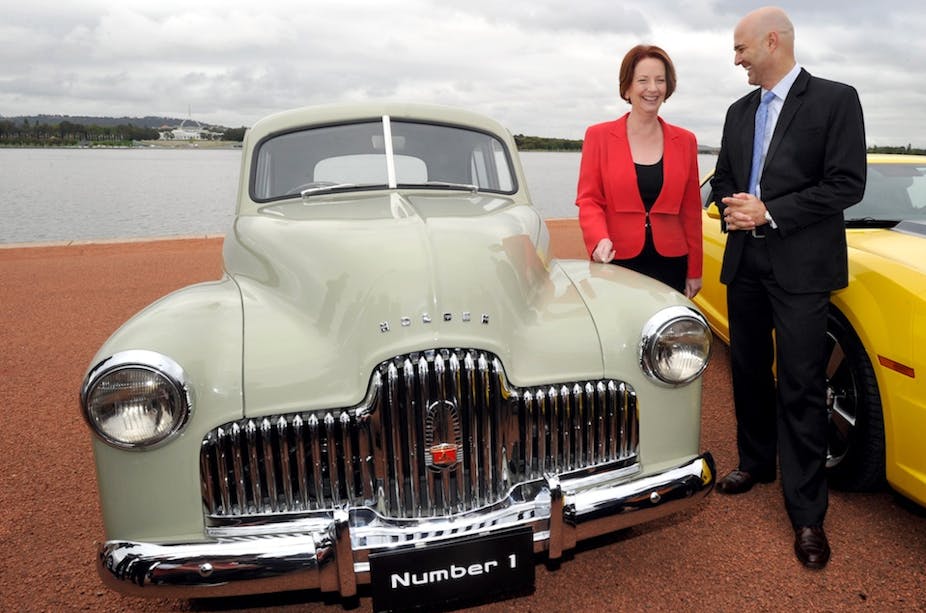Carmaker Holden will receive a $275 million government package, in return for committing to stay in Australia until 2022 and promising it will invest $1 billion.
Phillip Toner, senior research fellow, Centre for Industry and Innovation Studies at University of Western Sydney explains why this move is about technology, not jobs - and why it’s so hard to quantify the benefits.
Why should taxpayers be supporting an industry if it’s not internationally competitive?
That’s the central issue in this. There’s no simple answer, but one of the key responses is that every country that has a car industry supports it directly and indirectly - either through cash payments or by maintaining publicly-supported R&D facilities - for example advanced machining, metallurgy, ceramics - all the inputs that go into motor vehicles. That information is available for free or at a reduced cost for downstream users.
It’s simply not the case that there is, in the real world, a non-government supported car industry that stands on its own two feet and competes internationally on its own. For people to claim that’s the way the car industry should be simply ignores reality.
So why do governments support the car industry and other manufacturing sectors?
Fundamentally, it’s not the jobs argument - it’s technology. We can’t talk about this abstractly - to have a technological capability means having a local industry that uses those technologies.
For instance, for a country to maintain technology - say within its universities, with people studying engineering and science degrees and for the government to continue supporting those universities - there must be industries that directly employ those people. That’s the nub of it.
It’s the flow-on effect that’s important?
Exactly. Technological capacity on a national level doesn’t exist in a vacuum. Traditional orthodox economics has always had a difficulty in getting to grips with technology, partly because they deal with technology in a very abstract way. They deal with capital and labour as abstract quantities and technological change is just a variable in equations of economic growth. They are not really concerned with the mechanisms of knowledge generation and diffusion. Technological change is treated as a “black box” by orthodox economists because it leads to outcomes such as increasing returns to scale, temporary monopolies and a variety of market failures that upset their equilibrium models.
To overcome this major deficiency, a new academic discipline of innovation studies has been developed. Many of the leading figures in this field themselves have a science or engineering background. They have shown that to retain and develop a technological capacity means maintaining to some extent a variety of industries that use, make and embody those technologies. Broad-based technological capacity requires a complex of industries and supporting institutions that operate almost as a ecological system.
No particular industry can embody all technologies, but the car industry is considered strategic because it does range across an extraordinarily wide range of technologies - electronics, plastics, advanced machining, metallurgy, chemical engineering in paints and lubricants and supercomputing in design- all this has lots of ongoing R&D. The sort of technology needed to design and manufacture a seven speed automatic gear box, for instance, is really high-level stuff.
But how can taxpayers know they are getting the value of money, especially when car companies routinely threaten to go elsewhere unless they receive subsidies?
Yes, how can one quantify the benefits? Really, what you’re asking for is how one can set up a cost-benefit analysis. It is extraordinarily difficult to quantify the flows of technology and place a dollar figure on their current and potential value.
The first problem is calculating current “spillover benefits” to other industries that use these or similar technologies. Second, estimating future potential uses. One of the problems you’ve got is: what time-frame?
Any cost-benefit analysis relies on some sort of distant future benefits - but what sort of duration should we be looking at? You are talking about potential uses of technology into the future - and we simply don’t know what they will be. Technological forecasting is an imprecise activity. Third, then you have to construct other alternative mechanisms that can achieve the same result of retaining and diffusing that technology and then compare the costs of each different approach. People have been struggling with this problem for a long time!
And there is no doubt that car makers engage in inter-country arbitrage. They are quite open about it. But the thing for governments to do is to try and screw as much as possible, in the way of inward technology flows from the big car companies and to make them do the maximum R&D locally. For example, making sure Australia is not left just with internal combustion production and R&D but gets centrally involved in designing and making alternative car power plants.
Australia really is at the crossroads in this. It’s a first-world country but confronting a diminishing technology base. The critical thing about the mining industry is that most of the technology is imported.
The total output of local mining related services and innovative manufacturers is about $9 billion a year - peanuts. It’s 2.2% of total manufacturing sales. Is it possible to maintain first world living standards with a declining technological base? That’s the big experiment Australia is embarking on.

